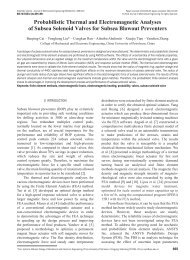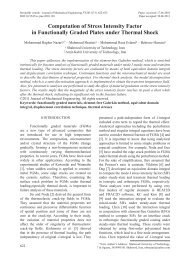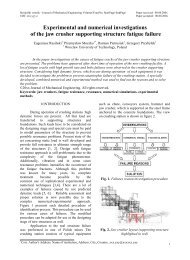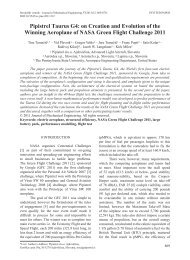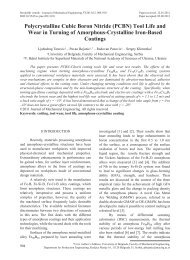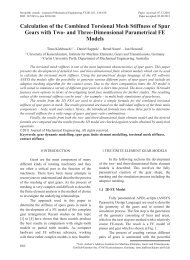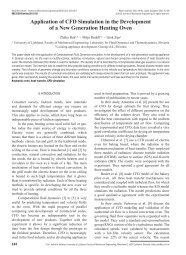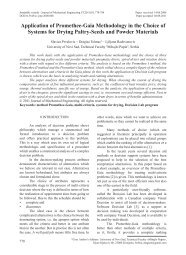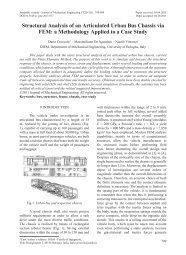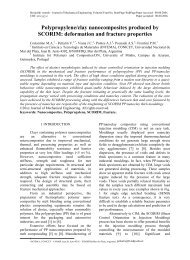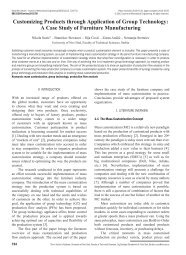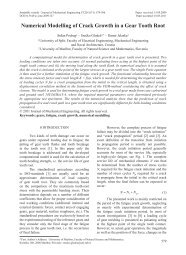Simulation of Water-Gas Shift Membrane Reactor for Integrated ...
Simulation of Water-Gas Shift Membrane Reactor for Integrated ...
Simulation of Water-Gas Shift Membrane Reactor for Integrated ...
- No tags were found...
Create successful ePaper yourself
Turn your PDF publications into a flip-book with our unique Google optimized e-Paper software.
Strojniški vestnik - Journal <strong>of</strong> Mechanical Engineering 57(2011)12, 911-926The reactor achieves only 50% COconversion because the extraction <strong>of</strong> H 2 is tooslow and it does not shift the equilibrium as far tothe product side as in the base case scenario.3.1.4 Influence <strong>of</strong> <strong>Reactor</strong>’s Surface Area andH 2 Molar Fraction in Permeated Stream on COConversionThe influence <strong>of</strong> the reactor’s surface areaon CO conversion was studied by varying thelength <strong>of</strong> the reactor. Additionally, the influence<strong>of</strong> different molar compositions in the permeatestream was studied. By changing both parametersTable 4 was obtained.The table shows that reducing the molarfraction <strong>of</strong> H 2 in the permeate stream wouldfavour the CO conversion. This is due to the factthat the partial pressure <strong>of</strong> H 2 is lower and thus,enhances the flux through the membrane whichindirectly affects the CO conversion.Increasing the reactor’s surface, byextending the length <strong>of</strong> the reactor, also favoursthe CO conversion. By enlarging the membranesurface area, more H 2 can permeate through,which shifts the WGSR more to the product side,and helps improve the CO conversion.To further determine the influence <strong>of</strong>surface area, the reactor with 70 m in length andH 2 molar fraction x H2 = 0.45 was simulated. Thereactor achieved only 92.3% CO conversion. Thisshows that extending a reactor further would helpachieve better conversions, but from economicpoint <strong>of</strong> view investment costs would be enormousto build such a big reactor. As discussed in earlierchapters, it would be better to use the catalystbecause the surface area is already large enoughand in the latter part <strong>of</strong> the MR the limitingprocess is the WGSR rate.3.2 <strong>Simulation</strong> Results in Aspen PlusThe model simulated on the basis <strong>of</strong> thecalculations obtained from the Mathematica basecase model is presented in the previous subchapter.Table 4. CO conversion at different H 2 molar fractions and lengths <strong>of</strong> reactorL = 30 m L = 40 m L = 50 mX COn N2[mol/s]n P,H2[mol/s]X COn N2[mol/s]n P,H2[mol/s]X COn N2[mol/s]n P,H2[mol/s]x H2 0.5 87.0 2664.53 2664.49 89.1 2707.63 2707.57 90.2 2730.35 2730.30.45 88.0 3281.43 2684.73 90.1 3335.05 2728.57 91.2 3363.35 2751.820.55 86.0 2162.35 2642.9 88.0 2196.87 2685.16 89.1 2215.03 2707.32Table 5. Molar compositions <strong>of</strong> gas streams(see Fig. 13)Rawgas (on the exit from the gasifier)species CO H 2 H 2 O CO 2 Ar H 2 S N 2 COS HClx i 0.560 0.230 0.120 0.077 4.8∙10 -3 4.5∙10 -3 4.0∙10 -3 3.9∙10 -4 6.7∙10 -5Syngas (after quench)species H 2 O CO H 2 CO 2 Ar H 2 S N 2 COS HClx i 0.410 0.375 0.154 0.052 3.2∙10 -3 3.0∙10 -3 2.7∙10 -3 2.6∙10 -4 4.5∙10 -5<strong>Gas</strong>-2 (retentate stream on the exit <strong>of</strong> the MR)species CO 2 H 2 O CO Ar H 2 S N 2 H 2 COS HClx i 0.769 0.140 0.072 6.3∙10 -3 5.9∙10 -3 5.3∙10 -3 5.3∙10 -4 5.2∙10 -4 8.8∙10 -5<strong>Gas</strong>-3 (after catalytic burner)species CO 2 H 2 O SO 2 Ar N 2 O 2 CO H 2 H 2 Sx i 0.835 0.146 6.4∙10 -3 6.2∙10 -3 5.2∙10 -3 2.0∙10 -3 0 0 0GT-gas (permeate stream on the exit <strong>of</strong> the MR)species H 2 N 2 CO H 2 O CO 2 Ar H 2 S COS HClx i 0.5 0.5 0 0 0 0 0 0 0922 Lotrič, A. ‒ Sekavčnik, M. ‒ Kunze, C. ‒ Splieth<strong>of</strong>f, H.



